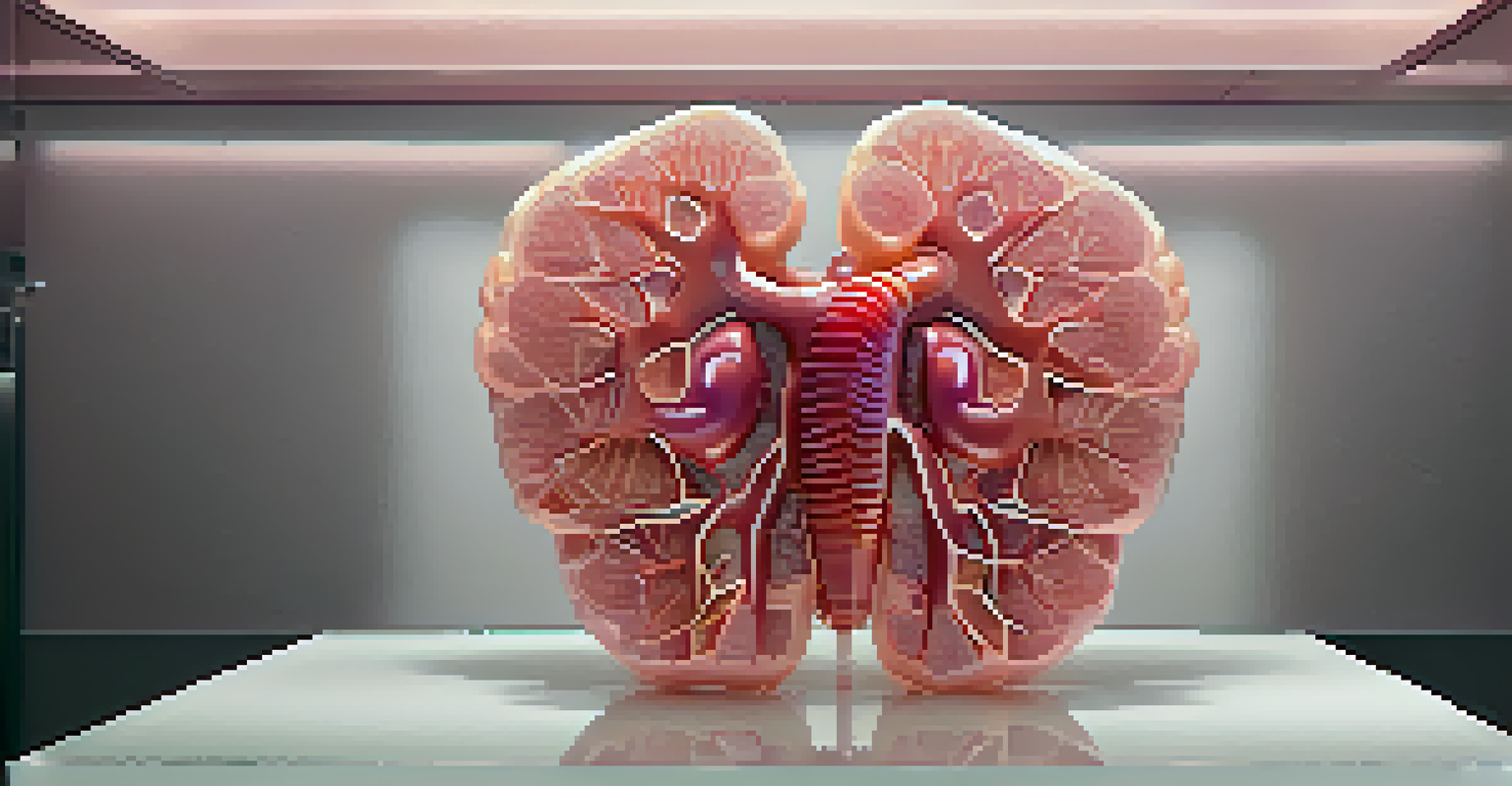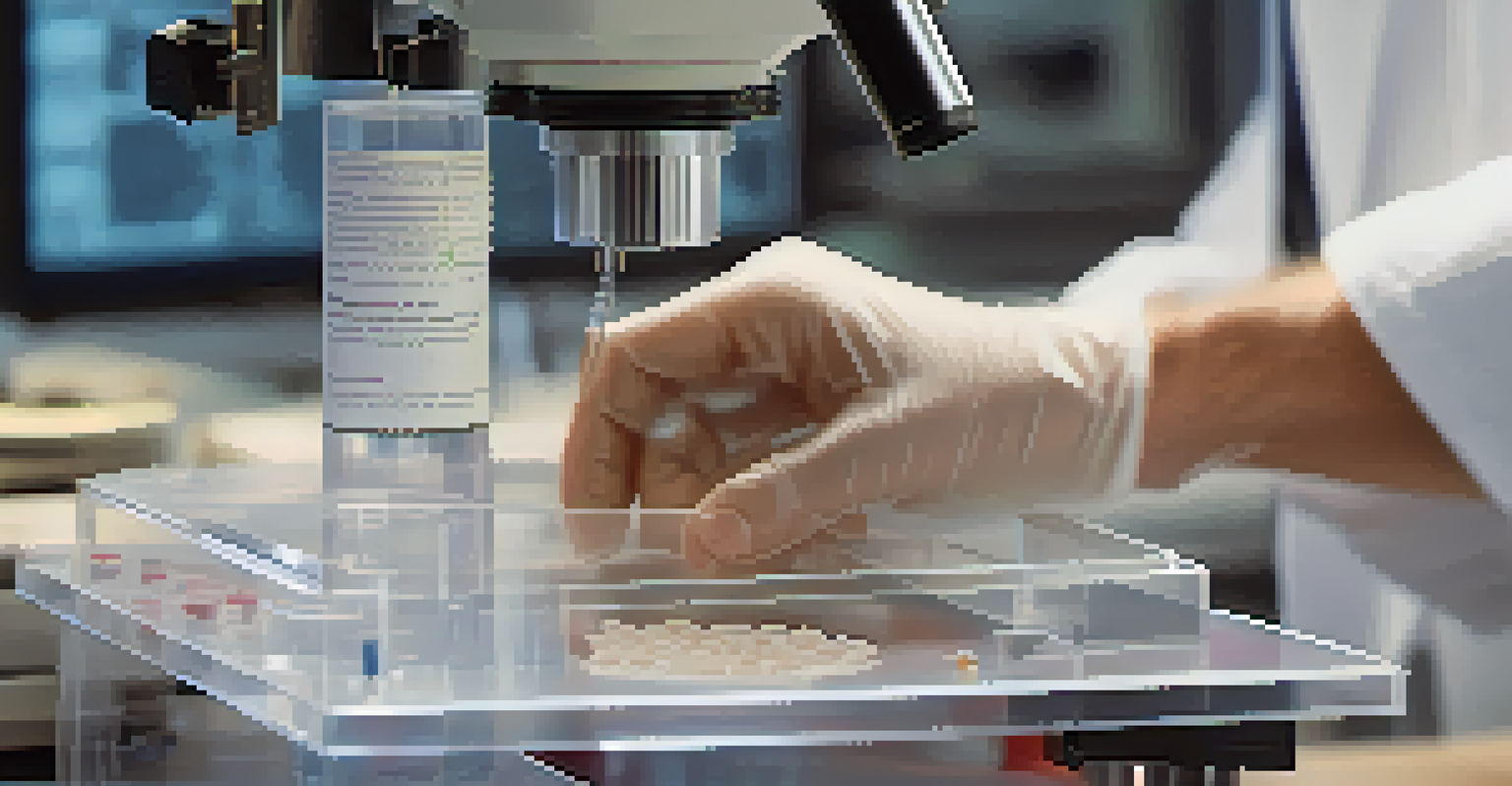The Impact of 3D Bioprinting on Regenerative Medicine's Future

What is 3D Bioprinting and How Does It Work?
3D bioprinting is an innovative technology that combines biology and engineering to create living tissue structures. By layering cells and biomaterials, scientists can print tissues that mimic the natural architecture of human organs. This process uses a computer-aided design, allowing for precise control over the shape and composition of the printed structures.
The future of medicine is not just about treating diseases but about creating solutions that are tailored to individual needs.
Imagine a traditional printer, but instead of ink, it uses living cells to produce tissues. This technology enables researchers to create complex structures that could one day replace damaged organs or tissues in the body. The ability to customize these structures is a game-changer, as it allows for personalized medicine tailored to individual patients.
While still in its infancy, 3D bioprinting holds immense potential in regenerative medicine, paving the way for breakthroughs in organ transplantation and tissue repair. As research progresses, we may soon see bioprinted tissues used in clinical settings, significantly improving patient outcomes.
The Role of 3D Bioprinting in Organ Transplants
One of the most exciting applications of 3D bioprinting is its potential to address the organ transplant shortage. With millions of people waiting for transplants, bioprinting could provide an alternative solution by creating organs on demand. This not only reduces waiting times but also eliminates the risk of organ rejection since the organs can be printed using a patient's own cells.

Imagine receiving a new organ designed specifically for your body, made from your own cells. This personalized approach could dramatically reduce complications and improve the success rates of transplant surgeries. As researchers continue to refine bioprinting techniques, the dream of growing organs in the lab may soon become a reality.
3D Bioprinting Revolutionizes Medicine
This innovative technology combines biology and engineering to create living tissues, paving the way for advancements in organ transplants and personalized medicine.
However, challenges remain, such as vascularization—the process of creating blood vessels within printed tissues. Overcoming this hurdle is crucial for ensuring that bioprinted organs function effectively once implanted. Despite these challenges, the potential impact of 3D bioprinting on organ transplantation is profound.
Advancements in Tissue Engineering Through 3D Bioprinting
Tissue engineering is another field poised for transformation through 3D bioprinting. By creating tissues that can mimic the structure and function of real organs, researchers can better understand diseases and develop effective treatments. This technology allows for the creation of models that can be used for drug testing, reducing the reliance on animal models.
3D bioprinting holds immense potential to change the landscape of organ transplantation and regenerative medicine.
Think of it as creating a miniature version of a human organ in the lab. These bioprinted tissues can provide valuable insights into how diseases progress and how they can be treated. For instance, bioprinted liver tissues are being used to study liver diseases and test new medications, bringing us closer to personalized medicine.
As the technology advances, we can expect to see a shift in how medical research is conducted. Bioprinted tissues could lead to faster drug development and more effective treatments, ultimately improving patient care.
Challenges Facing 3D Bioprinting in Medicine
Despite its potential, 3D bioprinting faces several challenges that need to be addressed for it to become a mainstream solution in regenerative medicine. One significant obstacle is ensuring that the printed tissues can integrate seamlessly with the body. This includes not just the physical connection but also the functional integration with the body's systems.
For example, when a bioprinted organ is implanted, it must establish a connection with blood vessels and nerves to function properly. Achieving this level of complexity is a significant hurdle for researchers. Furthermore, maintaining the viability of cells during the printing process is crucial, as cells can become damaged or die during bioprinting.
Overcoming Challenges in Bioprinting
For 3D bioprinting to become mainstream, researchers must address challenges such as tissue integration and cell viability during the printing process.
Addressing these challenges will require a combination of innovative materials, advanced printing techniques, and a deeper understanding of biological processes. As the field evolves, overcoming these hurdles will be essential for realizing the full potential of 3D bioprinting in medicine.
Ethical Considerations of 3D Bioprinting
As with any groundbreaking technology, 3D bioprinting raises ethical questions that must be carefully considered. Issues such as the sourcing of cells, the potential for creating synthetic tissues, and the implications of 'playing God' in the lab are topics of ongoing debate. It's essential for scientists and ethicists to work together to establish guidelines that ensure responsible use of this technology.
For instance, if we can create organs from scratch, what does that mean for organ donation rates? Will fewer people choose to donate if they believe organs can simply be printed? These are critical questions that society must address as we move forward with bioprinting technology.
Moreover, as we develop the capability to print human tissues, we must also consider the implications for human enhancement and genetic modification. It’s vital to engage in discussions about what is ethically acceptable in the realm of regenerative medicine and to ensure that advancements benefit everyone.
Future Prospects: 3D Bioprinting in Clinical Settings
Looking ahead, the integration of 3D bioprinting into clinical settings appears promising. As technology advances and researchers overcome existing challenges, we may soon see bioprinted tissues and organs being used in hospitals. This could revolutionize how we approach complex medical issues, such as chronic diseases and injuries.
Imagine a future where patients receive bioprinted skin grafts for burn treatment or artificial cartilage for joint repair. These advancements could lead to quicker recovery times and improved quality of life for countless individuals. The ability to customize treatments based on a patient's unique needs is a significant step toward personalized healthcare.
Ethical Implications of Bioprinting
As 3D bioprinting advances, ethical considerations regarding cell sourcing and the potential impact on organ donation must be carefully examined.
While we are not there yet, ongoing research and clinical trials in 3D bioprinting are paving the way for these innovations. As the field evolves, it's essential to stay informed and engaged with the developments that could reshape the future of medicine.
The Intersection of 3D Bioprinting and Patient Care
The ultimate goal of 3D bioprinting is to improve patient care by providing solutions that are tailored to individual needs. This technology can help bridge the gap between traditional medicine and personalized treatment, making healthcare more effective and accessible. By leveraging 3D bioprinting, we can create solutions that address the unique challenges faced by different patients.
For example, bioprinted tissues could be used to test how a specific patient responds to a medication before it is prescribed, minimizing the risk of adverse effects. This level of customization in treatment plans could lead to better health outcomes and more efficient use of healthcare resources.

As we continue to explore the possibilities of 3D bioprinting, it's essential to keep the focus on improving patient care and ensuring that these technologies are accessible to everyone. The journey is just beginning, and the future holds incredible promise for the intersection of technology and medicine.